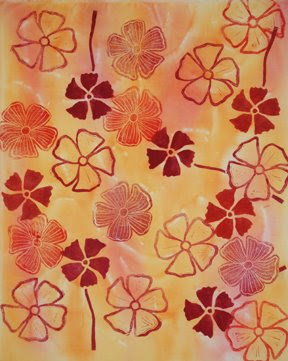








Art Cloth #2, Step 3

Art Cloth #2, Step 4

Art Cloth #2, Step 5

Art Cloth #2, Step 6

Art Cloth #2, Step 7

I am not that thrilled with this finished piece. I think it is the dark green rock shapes. Do you like it?
Also, I think Step 6 looks better in the photo than it did in person. The spirit people looked more prominent to me when the piece was on my design wall; however, maybe I should have lived with it a little before added the turquoise sponging over them. One thing I noticed as I took pictures of the steps is that the work almost always looked better in the photo than on the design wall. Any thoughts?
 go, I made a plate of gelatin according to the directions in Rayna Gillman's book, Create Your Own Handprinted Cloth. Several of the pieces I printed have been used in fabric collages. Last week I decided I wanted to experiment with using gelatin prints in art cloth for my Creating your own Stamps and Stencils for Art Cloth class at AZ Art Supply in Tucson. (BTW ART CLOTH is cloth TRANSFORMED by adding or subtracting color, line, shape, texture, value, or fiber to CREATE a compelling surface.)
go, I made a plate of gelatin according to the directions in Rayna Gillman's book, Create Your Own Handprinted Cloth. Several of the pieces I printed have been used in fabric collages. Last week I decided I wanted to experiment with using gelatin prints in art cloth for my Creating your own Stamps and Stencils for Art Cloth class at AZ Art Supply in Tucson. (BTW ART CLOTH is cloth TRANSFORMED by adding or subtracting color, line, shape, texture, value, or fiber to CREATE a compelling surface.) Art Cloth #1, Steps 4-5
Art Cloth #1, Steps 4-5 
Art Cloth #1, Step 6
 Art Cloth #1, Step 7
Art Cloth #1, Step 7






I sun printed this fabric with a rubber carpet grid which had been stored folded up. As a result not all of it laid flat on the fabric producing faded areas of the grid on the fabric. I liked this serendipitous result.